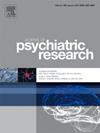慢性失眠患者在完成语言流畅性任务时的皮层激活和功能连接:多通道近红外光谱研究
IF 3.2
2区 医学
Q1 PSYCHIATRY
引用次数: 0
摘要
背景慢性失眠患者表现出不同程度的认知功能障碍。不同脑区的功能连接有助于了解大脑皮层的基本认知过程。然而,目前尚未对慢性失眠患者进行这方面的研究。本研究旨在利用言语流利性任务(VFT)阐明慢性失眠患者和健康对照组(HCs)大脑活动模式之间的差异。结果在任务期间,两组患者的 VFT 结果无显著差异;与健康对照组相比,慢性失眠患者在主要位于前额叶皮质的通道和脑区的氧血红蛋白血流动力学反应中显示出的皮质激活明显较少(FDR 校正 p <0.05)。结论我们的研究为慢性失眠患者执行功能的动态检测提供了神经学证据。与普通失眠症患者相比,慢性失眠症患者的大脑活动水平较弱,与任务相关的功能连通性降低。本文章由计算机程序翻译,如有差异,请以英文原文为准。
Cortical activation and functional connectivity during a verbal fluency task in patients with chronic insomnia: A multi-channel NIRS study
Background
Patients with chronic insomnia exhibit varying degrees of cognitive dysfunction. Functional connectivity of different brain regions contributes to the understanding of underlying cognitive processes in the cerebral cortex. However, this has not yet been studied in patients with chronic insomnia. This study aimed to elucidate the differences between brain activity patterns in patients with chronic insomnia and healthy controls (HCs) using a verbal fluency task (VFT).
Methods
We recruited 84 patients with chronic insomnia and 81 HCs. Oxy-haemoglobin (Oxy-Hb) concentrations in the brains of the participants were monitored using functional near-infrared spectroscopy (fNIRS) while performing the VFT.
Results
During the task period, no significant difference was observed between the VFT results of the two groups; patients with chronic insomnia showed significantly less cortical activation in haemodynamic responses of oxy-Hb at channels and brain regions mainly located in the prefrontal cortex compared to HCs (FDR-corrected p < 0.05). Moreover, the average channel-to-channel connectivity strength of patients in the chronic insomnia group was lower than that of those in the HC group (t = −6.717, p < 0.001).
Conclusion
Our study provides neurological evidence for the dynamic detection of executive function in patients with chronic insomnia. Compared to HCs, patients with chronic insomnia exhibit weaker levels of brain activity and reduced task-related functional connectivity.
求助全文
通过发布文献求助,成功后即可免费获取论文全文。
去求助
来源期刊

Journal of psychiatric research
医学-精神病学
CiteScore
7.30
自引率
2.10%
发文量
622
审稿时长
130 days
期刊介绍:
Founded in 1961 to report on the latest work in psychiatry and cognate disciplines, the Journal of Psychiatric Research is dedicated to innovative and timely studies of four important areas of research:
(1) clinical studies of all disciplines relating to psychiatric illness, as well as normal human behaviour, including biochemical, physiological, genetic, environmental, social, psychological and epidemiological factors;
(2) basic studies pertaining to psychiatry in such fields as neuropsychopharmacology, neuroendocrinology, electrophysiology, genetics, experimental psychology and epidemiology;
(3) the growing application of clinical laboratory techniques in psychiatry, including imagery and spectroscopy of the brain, molecular biology and computer sciences;
 求助内容:
求助内容: 应助结果提醒方式:
应助结果提醒方式:


